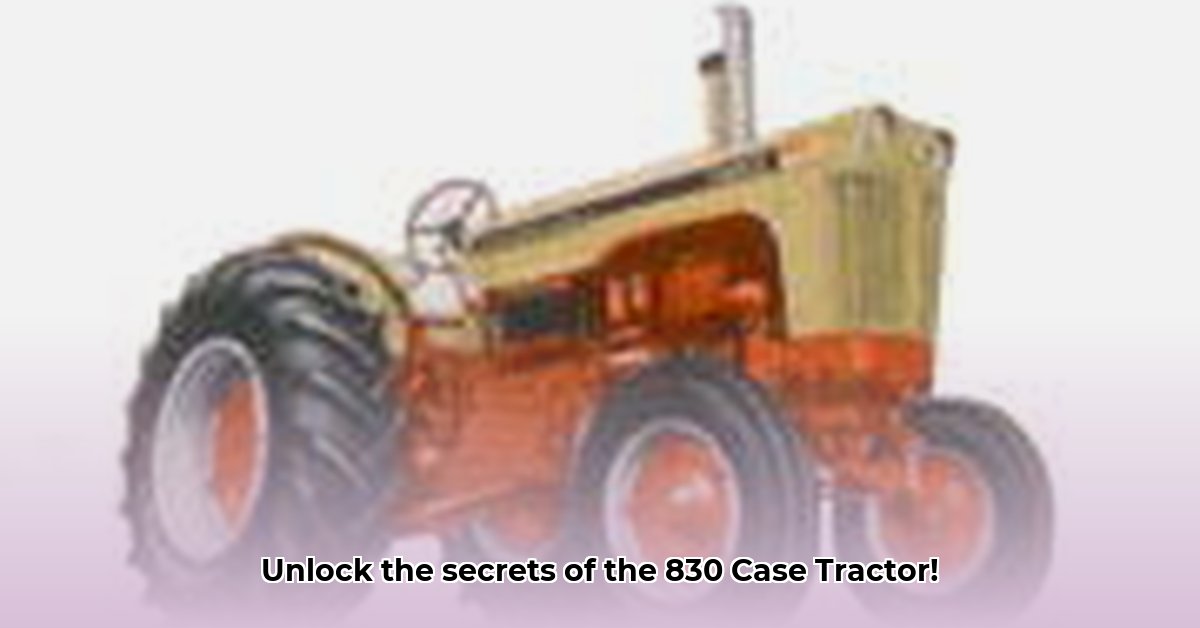
830 Case Tractor Specs: A Deep Dive into Farming History
The J.I. Case 830 tractor, produced from 1960 to 1969, holds a significant place in agricultural history. This guide delves into its specifications, addressing inconsistencies found in various sources and highlighting its importance to collectors, historians, and enthusiasts. For more information on Case tractor manufacturing locations, see Case tractor locations.
Engine: Powering the Fields
The Case 830's 4.9-liter, four-cylinder diesel engine is its powerhouse. However, reported horsepower varies, ranging from approximately 66 to 73.3 horsepower. This discrepancy likely stems from differences in testing methodologies and potential variations between production models. Further research using original Case documentation is needed for definitive clarification. What factors might account for the differences in reported horsepower?
Transmission: Shifting Gears
The Case 830 offered both an eight-speed manual transmission and a torque converter option. While sources generally agree on these choices, information regarding corresponding braking systems remains inconsistent and requires further investigation using primary sources. Did the transmission type influence the braking system design?
Fuel System: Tank Capacity and Efficiency
The tractor featured an approximately 83-liter fuel tank. Fuel efficiency, as expected, varied with workload and terrain—a rocky hillside demanding more fuel than flat land. This variability is crucial for understanding the operating costs associated with the 830 during its operational years. How did fuel consumption influence the overall economic viability of the Case 830 for farmers?
Model Variations: Adaptability to Farming Needs
Case offered several 830 configurations: a standard-tread model, a row-crop model, and the high-clearance Western Special. This range reflects the tractor's adaptability to various agricultural applications and the diverse needs of farmers in the era. How did the different configurations cater to different farming practices?
Operator Station Design
The Case 830's operator station was a simple, open design, lacking the climate control and advanced features of modern tractors. This simplicity reflects the technological standards of the time, prioritizing functionality and ease of maintenance. How did this design philosophy compare to later tractor models?
Data Discrepancies: Comparing Sources
Analysis of various online sources revealed inconsistencies. The following table highlights these discrepancies and underscores the need for original factory documents for complete accuracy:
| Specification | Source A | Source B | Notes |
|---|---|---|---|
| Horsepower | Approximately 66 hp | Approximately 73.3 hp | Variances are likely due to testing methods and model differences. |
| Engine Size | 4.9L, 4-cylinder diesel | 4.9L, 4-cylinder diesel | Consistent across sources. |
| Fuel Capacity | Approximately 83 liters | Approximately 83 liters | Consistent across sources. |
| Transmission Options | 8-speed, Torque Converter | 8-speed, Torque Converter | Consistent across sources. |
| Braking System | Needs further research | Needs further research | Inconsistencies require verification via original manuals. |
Restoring a J.I. Case 830: A Step-by-Step Guide
Restoring a Case 830 involves more than mechanical repair; it's about preserving a piece of agricultural heritage. This section provides a structured approach to the restoration process.
- Assessment: Begin with a thorough evaluation of the tractor's condition, documenting damage with photographs and notes. This creates a clear roadmap for the restoration project.
- Parts Sourcing: Locating parts is a significant challenge. Utilize online forums (like Yesterday's Tractors [1]), online auctions, and salvage yards. Consider compatible parts from similar Case models, confirming compatibility beforehand.
- Disassembly: Methodically dismantle the tractor, meticulously labeling all components to ensure accurate reassembly. This step requires patience and attention to detail.
- Cleaning and Repair: Thoroughly clean each part. Address rust and damage, repairing or replacing components as needed, prioritizing original parts.
- Reassembly: Carefully reassemble the tractor, referring to the detailed documentation created during disassembly. Meticulousness greatly enhances the success rate.
- Testing and Fine-Tuning: Finally, perform a comprehensive system test, adjusting and fine-tuning as necessary to ensure optimal functionality and safety.
This meticulous process allows for the restoration of a Case 830 to its original glory. [1]: https://forums.yesterdaystractors.com/threads/case-830-831-restoration.1425603/